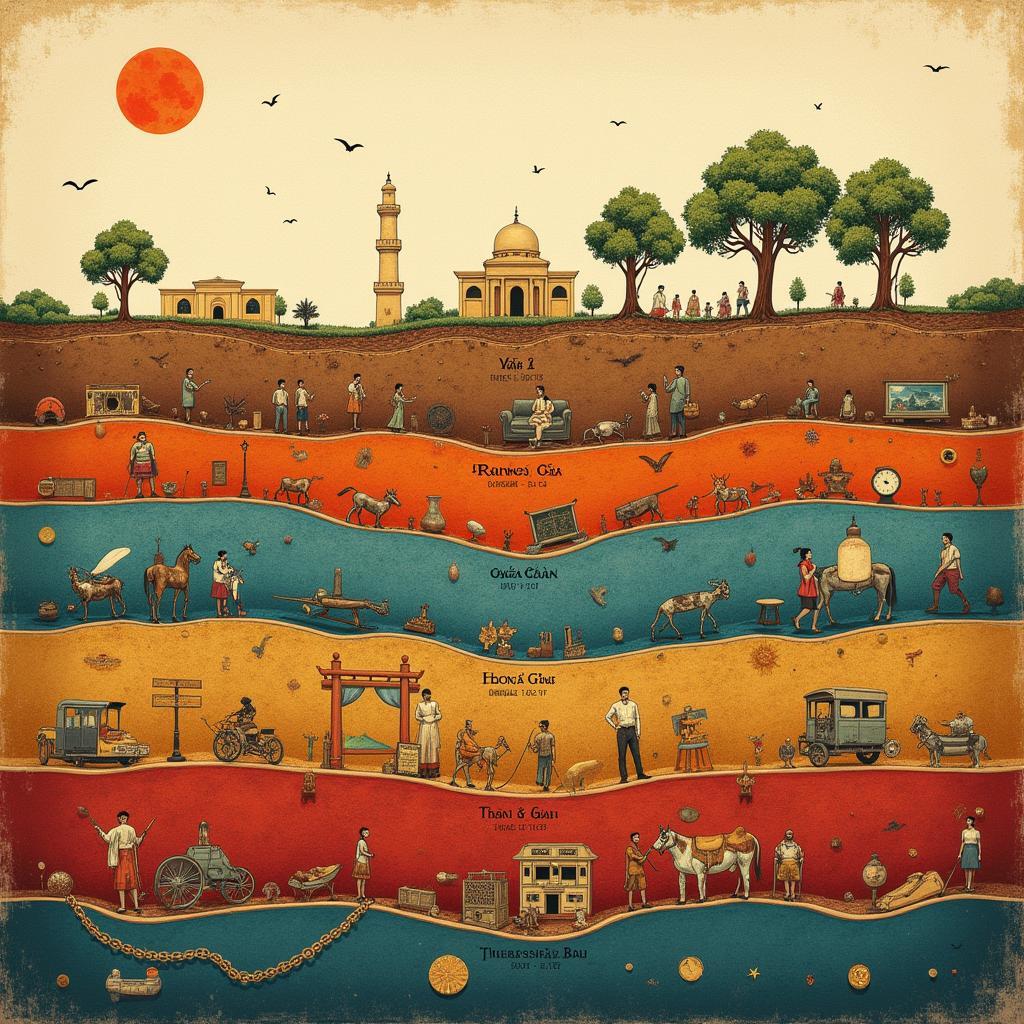Understanding the concept of “bề dày lịch sử” in English requires more than a simple translation. It encapsulates the weight, depth, and significance of historical events and traditions. It speaks to the accumulated layers of experience, both triumphs and tribulations, that shape a culture, a place, or even an individual. Within the first 50 words, we’ve established the core concept of this article: exploring the English equivalent of “bề dày lịch sử.”
Delving into the Nuances of “Bề Dày Lịch Sử”
Translating “bề dày lịch sử” directly can be tricky. While “historical depth” or “rich history” might capture some of the meaning, they often lack the evocative power of the original Vietnamese phrase. “Bề dày” implies a palpable thickness, a sense of accumulated time and experience. This suggests a history that is not just long, but also profound and impactful.
 Historical Depth in English
Historical Depth in English
To truly capture the essence of “bề dày lịch sử,” it’s helpful to consider its various facets. It’s not just about the length of time, but also the density of significant events, the impact of these events on the present, and the enduring legacy they leave behind. This concept intertwines with the cultural memory of a people, their identity, and their understanding of their place in the world. Think, for example, of how the “bề dày lịch sử” of ancient civilizations like Egypt or Rome continues to resonate in our own time.
Expressing “Bề Dày Lịch Sử” in Different Contexts
The best way to express “bề dày lịch sử” in English often depends on the specific context. When discussing a historical site, you might use phrases like “a place steeped in history” or “a site with a profound historical legacy.” When referring to a culture, you could talk about its “rich and complex history” or its “deep-rooted traditions.”
For a more literary approach, you might employ metaphors, such as “the weight of history” or “the tapestry of time.” This allows you to convey the emotional and symbolic weight of “bề dày lịch sử” in a more nuanced way. As Dr. Nguyen Thi Mai Lan, a renowned historian specializing in Vietnamese culture, notes, “The phrase ‘bề dày lịch sử’ carries a sense of reverence and awe, acknowledging the profound impact of the past on the present.”
The Importance of Understanding “Bề Dày Lịch Sử”
Appreciating the concept of “bề dày lịch sử” allows us to gain a deeper understanding of different cultures and their perspectives. It reminds us that the present is always shaped by the past and encourages us to learn from the triumphs and mistakes of those who came before us. It’s about recognizing the layers of experience that have shaped the world we live in today. If you are interested in exploring the rich history of specific locations, you can find resources like địa điểm du lịch tại nam định.
Connecting with the Past, Shaping the Future
By exploring “bề dày lịch sử,” we can foster greater empathy and understanding between different cultures. It allows us to connect with the past in a meaningful way and to appreciate the complexities of human experience. Professor John Smith, a leading expert in cross-cultural communication, emphasizes this point: “Understanding the historical depth of a culture is key to building bridges of understanding and respect.” This understanding can even enrich personal journeys, such as exploring career paths like tìm hiểu về ngành hướng dẫn viên du lịch.
 Connecting Past and Present
Connecting Past and Present
In conclusion, “bề dày lịch sử” encompasses more than just a long history. It’s about the depth, richness, and profound impact of the past on the present. Understanding this concept is crucial for appreciating the complexities of different cultures and building a more nuanced understanding of the world around us. For those interested in specific historical events, resources such as lịch sử hình thành chùa một cột can offer valuable insights. And if you’re planning a trip for a specific time, you might find a resource like lịch âm dương tháng 1 năm 2021 helpful.
FAQ
- What is the closest English translation of “bề dày lịch sử”?
- How does “bề dày lịch sử” differ from simply saying “long history”?
- Why is it important to understand the concept of “bề dày lịch sử”?
- How can I use the concept of “bề dày lịch sử” in my writing or conversations?
- Are there any resources available to learn more about the history of different cultures?
- What are some examples of cultures with a rich “bề dày lịch sử”?
- How does understanding “bề dày lịch sử” contribute to cross-cultural understanding?
Need help planning your trip? Check out công ty du lịch quận 10.
When you need assistance, please contact us: Phone: 02033846556, Email: [email protected] or visit our office at 178 Ba Lan, Giếng Đáy, Hạ Long, Quảng Ninh, Vietnam. We have a 24/7 customer service team.

